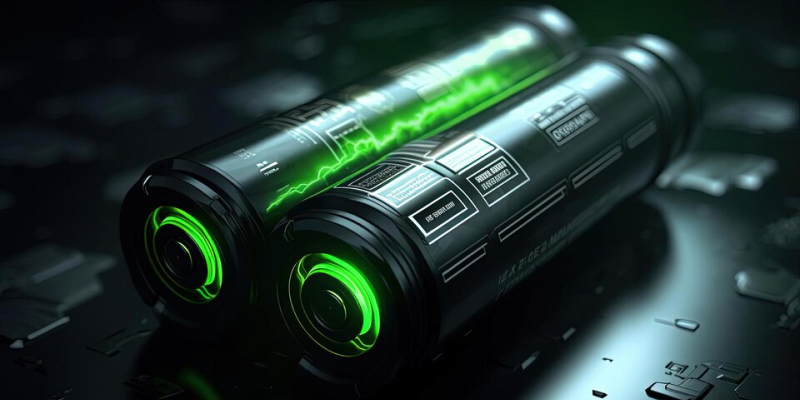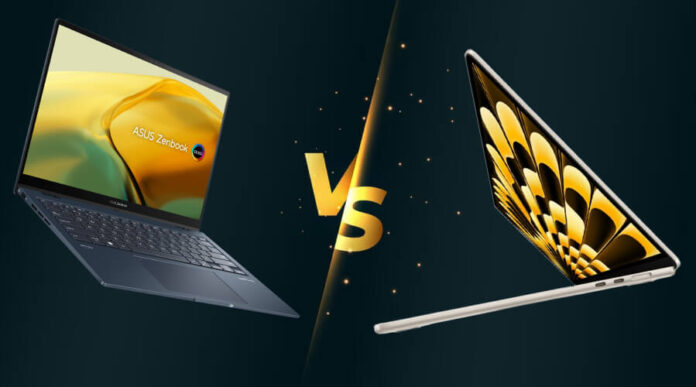In the dynamic landscape of ultrabooks, the Asus Zenbook 14 OLED (UM3402) vs Apple MacBook Air (M2, 2022) stand as compelling contenders, each boasting distinctive features that cater to diverse user preferences.
The Zenbook 14 OLED (UM3402) vs Apple MacBook Air (M2, 2022) comparison delves into the intricacies of these ultrabooks. The Zenbook 14 OLED’s emphasis on visual brilliance through its OLED display promises immersive experiences, while the MacBook Air (M2, 2022) builds on Apple’s legacy of sleek design and seamless integration. This exploration assists users in making an informed choice based on their needs.
Here is the detailed comparison
➨ Case
The Zenbook 14 OLED (UM3402) and MacBook Air (M2, 2022) compete in the vast realm of ultrabooks. Weighing 1.39 kg, the Zenbook flaunts a slender 16.9 mm profile and a 692 cm2 footprint. On the opposing side, the MacBook Air, at 1.24 kg, boasts an even lighter 11.3 mm chassis and a slightly smaller 654 cm2 area.
The Zenbook’s 82.2% screen-to-body ratio, framed by 6.1 mm side bezels, contrasts the MacBook Air’s 82% ratio with 5.6 mm. Aesthetically divergent, the Zenbook opts for a black hue, while the MacBook Air dazzles in Silver, Gold, Gray, and Blue options. Both aluminum-clad, these ultrabooks promise sleek, portable elegance, with the Zenbook’s versatile 180° opening angle eclipsing the MacBook Air’s 130° limit.
➨ Display and Size Comparison:
The Zenbook 14 OLED outshines with its 14-inch OLED display, boasting a higher resolution and refresh rate than MacBook Air’s 13.6-inch IPS LCD screen. This results in a 5% larger screen space with superior contrast ratios and color reproduction, offering users an immersive visual experience. The Zenbook’s 90 Hz refresh rate stands out for smoother transitions and crisper visuals.

➨ Cooling Solutions:
While both laptops incorporate cooling systems, the Zenbook 14 OLED employs an active cooling system with a single fan, leading to a noise level of up to 52.5 dB under maximum load. Conversely, the MacBook Air leans towards a passive cooling system, resulting in quieter operation but potentially limited efficiency during demanding tasks.
➨ Battery and Charging:
The Zenbook 14 OLED shines in the battery department, boasting a significantly larger 75 Wh battery than MacBook Air’s 52.6 Wh capacity. This translates to a longer runtime and quicker full charging time, reinforced by its 65W fast-charging capability, positioned advantageously on the right side for convenient access.

➨ Processing Capabilities:
Driven by the Apple M2 chip, the MacBook Air showcases superior single-core performance in benchmarks. However, the Zenbook’s AMD Ryzen processors excel in multi-core performance, especially with variants like the Ryzen 7 7730U that can rival the MacBook Air’s capabilities.
Also Read: Apple Pencil (2023) With USB Type-C Port: Specification and Features
➨ Graphics and Memory:
The MacBook Air’s Apple M2 GPU demonstrates exceptional graphics prowess compared to the Zenbook’s Radeon RX Vega 7. Nevertheless, the Zenbook offers configurations with larger RAM capacities, enhancing multitasking abilities and overall system efficiency.

➨ Storage and Connectivity:
Both laptops sport SSD storage, but the Zenbook’s user-upgradable storage option offers flexibility lacking in the MacBook Air. Connectivity-wise, the MacBook Air gains an edge with Thunderbolt 3 ports, while the Zenbook includes the rarity of an old-school USB-A port.
➨ User Convenience:
Featuring backlit keyboards and high-quality speakers, the MacBook Air, though slightly lighter and more compact, stands out with improved webcam resolution, delivering superior video conferencing experiences—a boon for remote workers and frequent video callers.
➨ Advantages
The Asus Zenbook 14 OLED (UM3402) emerges as a versatile powerhouse with standout features. Noteworthy is its inclusion of a classic USB-A port, catering to diverse connectivity needs. The higher screen refresh rate at 90 Hz promises a smoother visual experience, and a substantial 43% larger battery capacity ensures prolonged usage.
Additionally, the Zenbook’s impressive 600 nits maximum screen brightness enhances visibility. On the other hand, the Apple MacBook Air (M2, 2022) excels in portability, weighing 150 grams less, and offers superior webcam recording quality. These advantages reflect the nuanced strengths each laptop brings to the user experience.
Conclusion:
The Zenbook 14 OLED (UM3402) dazzles with its vivid display, extended battery life, and versatile connectivity. Conversely, the MacBook Air (M2, 2022) shines in compactness, single-core CPU performance, and robust GPU capabilities, ideal for users valuing portability and Apple’s ecosystem.
Ultimately, the choice between these stellar laptops hinges on personal priorities—be it display excellence, battery longevity, processing power, or allegiance to a particular operating system

